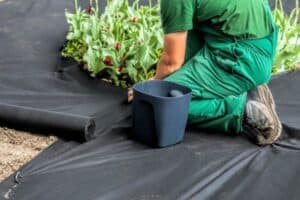Trellising plants can be a game-changer for gardeners with limited space.
Not only does it save space and make your garden look more organized, it also has lots of benefits for the plants themselves.
From improving air circulation to promoting better growth, trellising can take your garden to the next level.
In this article I’ll explore the top benefits of trellising plants and how you can start using this technique in your own garden.
This post contains affiliate links. Please read the disclosure for more info.

Benefits of Trellising Plants
1. Saves Space in the Garden
By using a trellis, you can grow climbing plants vertically, which saves valuable garden space.
This is especially helpful for small gardens, balconies or rooftop gardens where space is limited.
When you train your plants to grow up a trellis, you make better use of the available vertical space and you can grow more plants in a compact area.
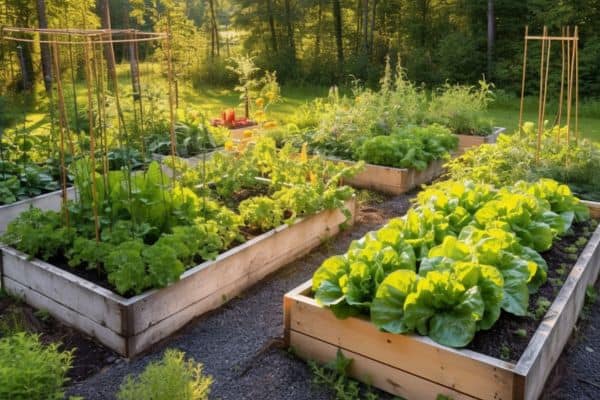
2. Improves Plant Health
Trellising helps to improve plant health by providing better airflow and exposure to sunlight.
The increased airflow reduces the growth of fungal diseases like damping-off and powdery mildew, and the enhanced sunlight exposure ensures that the leaves and fruit receive adequate light for growth and development. [1]
According to the University of Massachusetts Amherst, healthy, vigorous crops can tolerate some insect damage without affecting the yield.

3. Reduces Pests
Using a trellis helps to keep your plants off the ground, which reduces the risk of annoying pests damaging your plants.
Common garden pests like earwigs and slaters thrive in damp, crowded conditions, but trellising increases airflow and keeps the leaves and fruits away from the soil, so it’s harder for pests to infest your plants.
4. Increases Yield
Trellising plants can increase their yield by providing support for the vines and giving the plants plenty of space to grow and develop properly.
With adequate spacing and support, your plants can grow larger fruits and vegetables, and produce a bigger crop.
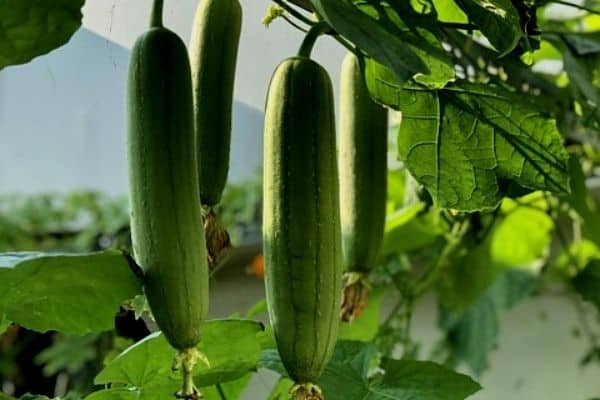
5. Easier to Harvest
It’s much easier to harvest the fruits and vegetables when they’re grown on a trellis.
You don’t have to bend over or reach into the dense foliage to pick your produce – it’ll be easily accessible and visible, so the harvesting process will be a lot quicker and more enjoyable.
6. Provides Shade to Neighboring Plants
Trellising can also provide much-needed shade to the plants growing below them, especially during the hot summer months.
The shaded area can be an ideal location for growing cool-season crops or plants that prefer less direct sunlight.
So for instance you could plant a row of lettuces next to cucumbers growing vertically on a trellis or plant cilantro next to climbing beans.
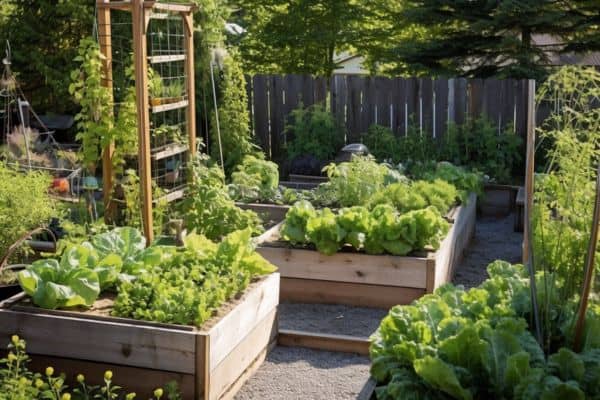
7. Creates a Focal Point in the Garden
A trellis can add visual appeal to your garden and turn an ordinary garden area into an eye-catching display.
Whether you choose a simple or elaborate design, a trellis serves as a beautiful focal point and adds vertical interest to your garden.
I like to grow sweet peas on a trellis next to my vegetable garden to bring in some color and attract beneficial insects.

Types of Trellises
Materials Used for Trellises
The most popular materials for building a trellis are timber, bamboo, and metal.
Timber trellises offer a warm, natural look and they can be painted or stained to match your outdoor decor.
Wooden trellises are budget-friendly, but they might require periodic maintenance to prevent rot and weathering.
Bamboo is a lightweight, eco-friendly material that is perfect for supporting lightweight climbing plants like peas and beans.
Be prepared for bamboo trellises to break down over time, though because they’re not as long-lasting as timber or metal options.
For a more robust, long-lasting trellis, metal is the way to go.
Metal trellises are strong and durable so they can support heavier plants like squash, pumpkins and heavy vines like wisteria.
Vertical vs. Horizontal Trellising
Beyond design, another crucial decision is choosing between vertical and horizontal trellising.
Vertical trellising is the most common method, guiding plants upward along a tall frame.
This option saves significant ground space, so you can grow more plants in a smaller area.
Vertical trellises work well for indeterminate tomato varieties, climbing fruits like passionfruit and kiwi fruit, and vegetables like pole beans and cucumbers.

Horizontal trellising, on the other hand, focuses on spreading plants laterally.
These trellis systems range from simple horizontal wires to more elaborate mesh structures.
This approach is ideal for growing plants that benefit from increased airflow and sunlight exposure, but it also requires more ground space compared to vertical trellising.

Best Plants for Trellising
Climbing Vegetables
As a landscape gardener specializing in small space gardens, I’m a big fan of growing climbing vegetable plants on trellises to help make the most of the garden space.
- Pole beans: These are productive plants that can be grown in narrow rows if trellised.
- Peas: Trellising peas can lead to a healthier and more bountiful harvest.
- Tomatoes: Indeterminate tomato varieties also benefit from trellising because they continue to grow throughout the season and can become quite large.
- Pumpkins: Small pumpkin varieties like Sugar Pie Pumpkins can be grown on sturdy trellises.
RELATED: 10 Climbing Vegetable Plants
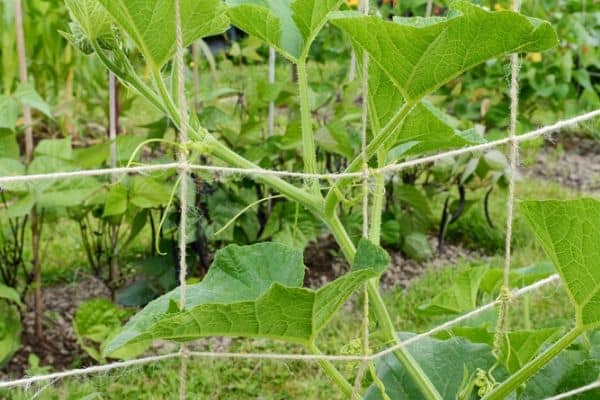
Climbing Fruits
Using trellises for climbing fruits can help you better manage plant growth and boost your yield.
- Grapes: Grape vines are easy to grow on trellises, but they need a sturdy structure to support the heavy fruit clusters.
- Berries: Raspberries, blackberries, gooseberries and blueberries are ideal for growing vertically on a trellis and it makes them much easier to pick.
- Melons: Certain melon varieties, such as cantaloupe and honeydew, can be grown vertically on strong trellises, but be sure to support the fruit with a sling as it grows heavier.
RELATED: 10 Climbing Fruit Plants

Ornamental Climbing Plants
Trellises aren’t just for edible plants; they can also make your garden more visually appealing with flowering climbing plants:
- Climbing Roses: Roses look beautiful growing on a trellis and they’ll bloom from late spring or early summer until fall.
- Vining nasturtium: Nasturtiums have bright, eye-catching flowers that can be a great addition to your trellis and they’re also edible.
- Clematis: These deciduous climbing perennial vines grow best in cool climates and look beautiful climbing up a trellis.
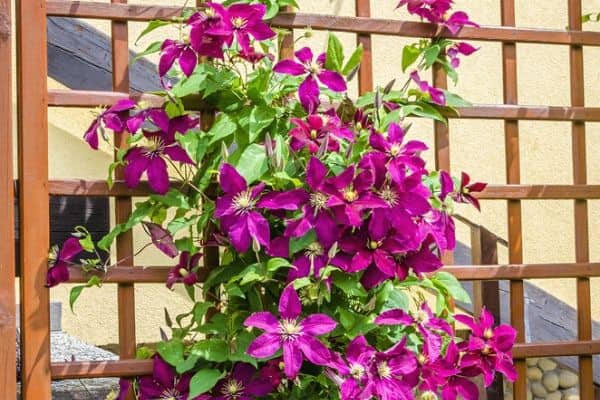
RELATED ARTICLES
- How To Grow Kiwi Fruits Vertically
- 11 Vertical Garden Mistakes to Avoid
- How To Grow Strawberries Vertically
- 10 Flowering Climbers
- How To Grow Pumpkins Vertically
Trellising plants offers numerous benefits, including maximizing space, encouraging healthy growth, and providing visual interest to your garden.
I hope this post has inspired you to set up a trellis to get the most out of your garden space.
Are you on Pinterest? Check out my Climbing Plants and Vegetable Gardening boards. You can also find me on Facebook.


